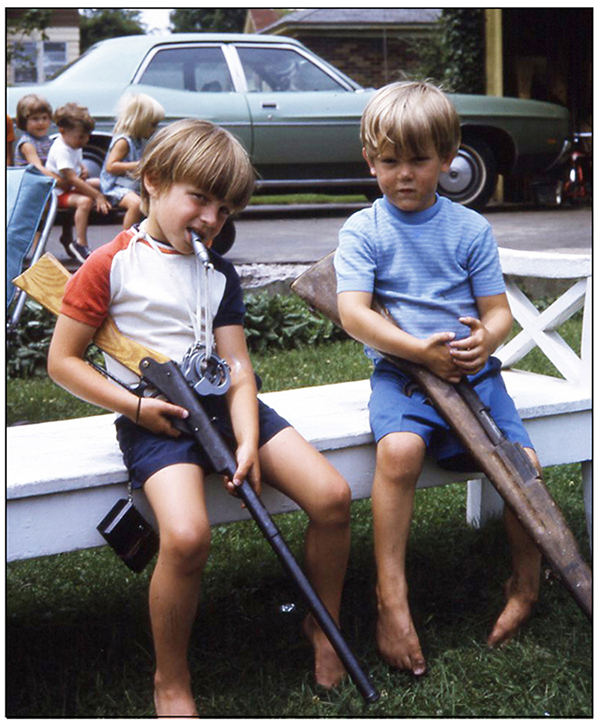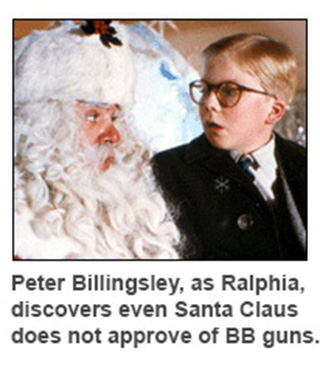| HOME |
 |
Ralphie Parker would understand In the photo are my son Jeff Major (left) and his cousin, Jim Smolinski, both five years old. We lived in Rhode Island, the Smolinskis in Massachusetts, neighboring states, but in cities far enough apart that we seldom visited each other. So, naturally, when we got together it was in Solvay, NY, where Jim's father and I had grown up. |
 |
I liked the photo for several reasons, not the least of which is in the background where my daughter, Laura, and nephew, Brian Chard, are taking a ride on the fabulous jit. The boy on the left could be Ralphie’s son, and what happened to my BB gun could have happened to Ralphie’s, but I'll never know. What I do know for sure is, as children, Ralphie and I were a lot alike. Millions of other adults could say the same thing. In the late 1970s, a director named Bob Clark suggested turning part of Shepherd’s novel into a Christmas movie, but Clark had no Hollywood track record at the time, so nobody paid attention. Then a funny thing happened. Well, millions of kids thought it was funny; several critics said otherwise. That funny thing was "Porky’s", a 1981 Clark film that became a smash box office hit. He followed it with "Porky’s II: The Next Day". With two successful films on his resume, Clark was able to get backing for the one he really wanted to make. Thus, in 1983, "A Christmas Story" was born. It promptly died at the box office. MEANWHILE, on the small screen, another box office failure, 1946’s "It’s a Wonderful Life", had become a Christmas classic. By accident. No station took more advantage of the situation than a small UHF channel in Rhode Island where I worked for many years at the Providence Journal. For awhile this station had a license to broadcast but little cash for programming, so it dipped into the well of public domain films. As I recall, there were about a dozen well-known old movies that had slipped through studio cracks. For this station, "It’s a Wonderful Life" was year ’round programming, though I couldn’t imagine anyone watching it in July. But if you were in the mood, there it was, on Channel 64, part of a small movie package that filled a limited schedule until the station became (I think) a Fox affiliate. OF COURSE, from Thanksgiving until New Year’s Day throughout the 1980s, "It’s a Wonderful Life" was everywhere. It’s only a slight exaggeration to say you could find it any time of day on some channel. Christmas simply wasn’t Christmas without "It’s a Wonderful Life". I always had goosebumps at the end of the movie when Bedford Falls residents show up to rescue honest, but beleaguered George Bailey (James Stewart), and I'd tear up when Harry Bailey (Todd Karns) proposed a toast “to my big brother George – the richest man in town.” It was Frank Capra schmaltz at its best; I can’t understand why 1946 movie audiences didn’t respond, though the theory is that after World War II people wanted comedy, not pathos, and "Wonderful Life" was considered a Depression-era story. Turned out the lapse into the public domain was just what the movie needed. It was on television so often that eventually everyone got around to watching it, discovering – surprise, surprise – that it was a wonderful movie, perhaps the best one Capra ever directed. FILLING THE VOID, thanks to Ted Turner's cable channels, was "A Christmas Story", presented at least 25 times each holiday season, including an around-the-clock marathon that begins Christmas Eve. This film takes a far different That’s why lots of old farts, like me, relate to Ralphie. We grew up in the ’40s when the gift of a BB gun was a rite of passage. In the movie, all the adults, even a department store Santa Claus, advise Ralphie against the gun, warning him, “You’ll shoot your eye out, kid.” Now, thanks to streaming services, we can watch both "It's a Wonderful Life" and "A Christmas Story" when we want and without commercials. Several who’ve written about the television success of "A Christmas Story" mistakenly credit the movie with popularizing that line. Truth is, “You’ll shoot your eye out” had been planted – some would say pounded – into our heads by our own parents long before the movie was made. "A Christmas Story" was an entertaining reminder. Despite the warning, Ralphie’s father – and our parents – caved in and purchased a BB gun. I had one, so did most of my friends. No eyes were shot out, though some of us were hit in the face. No, we weren't shooting at each other, but mishaps were inevitable and – in my neighborhood – the damage was slight. My closest call was when my cousins and I were shooting at tin soldiers in my Uncle Bill’s basement. A BB ricocheted off a wall, came straight back and hit my forehead. From then on I fired at a slight angle. No more accidents. I was sixteen when I last used a BB gun. It was a good time to quit because that experience resulted in the most remarkable shot of my life. I was dating a girl named Nancee Higbee – yes, that’s how she spelled her first name – and we were in her backyard when a pesty bumblebee came along. I never would have thought of using a BB gun on a bee ... though having written this sentence, the idea seems oddly logical, in a Dr. Seuss kind of way. The Higbees had a BB gun. Perhaps Nancee had a brother; I don’t recall. But she and/or her mother fetched the gun and I became The BB Bee Hunter. I put one BB down the barrel, cocked the gun and got as close as I could when the bee landed on something, I can’t remember what. I shot at the bee – and killed it. (“Sorry, officer, I didn’t realize it wasn’t bee hunting season.”) ALL OF THIS BB nonsense surfaced when I looked at that old photograph. Even in 1972, Jeff’s mother, Karla, was uncomfortable when her son played with toy guns, but she gamely tolerated the cowboy pistols given him by my parents. I also passed along two toy guns I had received as a child. The one Jim Smolinski is holding is a model of a World War II-era Army rifle, perhaps an M-1. It had only one moving part, a bolt that allowed you to pretend you were putting a bullet into a non-existent chamber. There was no barrel, though a short piece of metal attached to the stock gave the appearance of one. The trigger was a fixed piece of metal. The gun did come with an adjustable leather sling that let you carry the rifle on your shoulder, like a real soldier. This toy was strictly for show, and a very good show at that. When new, this rifle looked and felt like the real thing. What Jeff is holding in the photograph is my old BB gun. Most of it, at least. Which made me wonder if Ralphie Parker had given his BB gun to his son. If so, I hope he kept it intact. What’s missing from my BB gun is what we used to call “the insides”, a removable part of the barrel through which the BB was fired. Perhaps the technical term for this piece is “housing.” I'm not sure because I'm a man who knows little about guns and cars. In any event, without this piece, the gun will not fire anything. Karla or my mother had removed the housing and either threw it away or hid it so well that we never found it, though Jeff and I looked everywhere. Aside from the BB gun and the M-1 issued during my Army basic training, I’ve fired only one shot on a real firearm, and that was my Uncle Bill’s .22 rifle when I was a boy. It’s a weird memory that may not be accurate, but I believe I fired that .22 on the hill behind our house on Russet Lane in Solvay. What's weird is that if anyone today fired a .22 so close to a neighbor’s backyard – we’re talking about 100 feet – police would certainly be called. But in the 1940s it was not uncommon for people to do things considered dangerous today. Like allowing a child to have his own BB gun. In some states that's now illegal. Like me, Jeff grew up with a healthy fear of firearms, though there were times we both wished he could have used my BB gun. Hiding the barrel housing certainly wasn’t my idea. After all, you never know when some damn bee will come along. |
| HOME • CONTACT |
 look at the holiday than "Wonderful Life", but Shepherd's story may hit closer to home. It’s an often hilarious tale, set in the 1940s, about nine-year-old Ralphie and the one Christmas gift that will make him happy – a Red Ryder BB gun.
look at the holiday than "Wonderful Life", but Shepherd's story may hit closer to home. It’s an often hilarious tale, set in the 1940s, about nine-year-old Ralphie and the one Christmas gift that will make him happy – a Red Ryder BB gun.